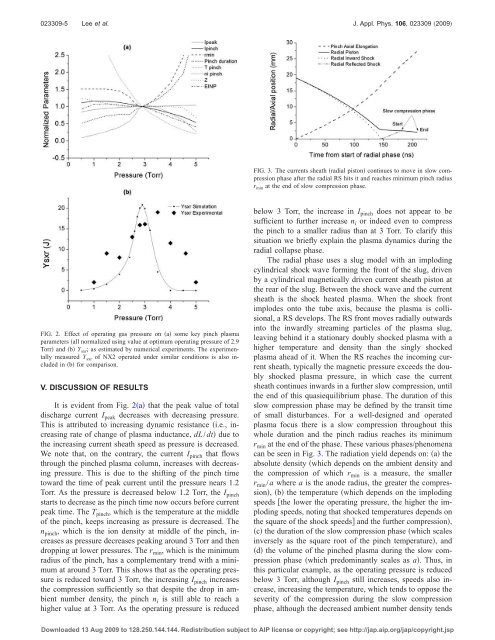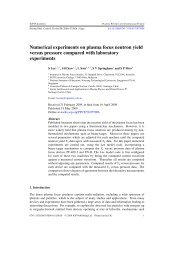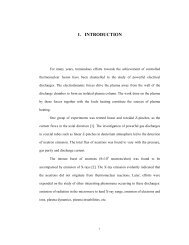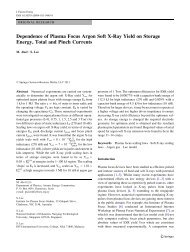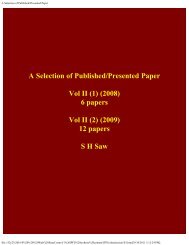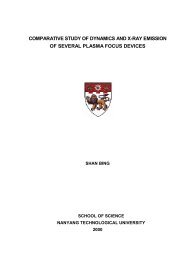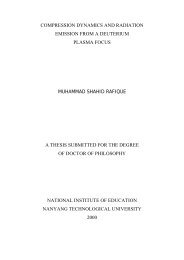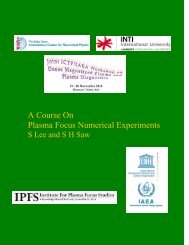023309-5 Lee et al. J. Appl. Phys. 106, 023309 �2009� FIG. 2. Effect of operating gas pressure on �a� some key pinch plasma parameters �all normalized using value at optimum operating pressure of 2.9 Torr� and �b� Y sxr; as estimated by numerical experiments. The experimentally measured Y sxr of NX2 operated under similar conditions is also included in �b� <strong>for</strong> comparison. V. DISCUSSION OF RESULTS It is evident from Fig. 2�a� that the peak value of total discharge current I peak decreases with decreasing pressure. This is attributed to increasing dynamic resistance �i.e., increasing rate of change of plasma inductance, dL/dt� due to the increasing current sheath speed as pressure is decreased. We note that, on the contrary, the current I pinch that flows through the pinched plasma column, increases with decreasing pressure. This is due to the shifting of the pinch time toward the time of peak current until the pressure nears 1.2 Torr. As the pressure is decreased below 1.2 Torr, the I pinch starts to decrease as the pinch time now occurs be<strong>for</strong>e current peak time. The T pinch, which is the temperature at the middle of the pinch, keeps increasing as pressure is decreased. The n pinch, which is the ion density at middle of the pinch, increases as pressure decreases peaking around 3 Torr and then dropping at lower pressures. The r min, which is the minimum radius of the pinch, has a complementary trend with a minimum at around 3 Torr. This shows that as the operating pressure is reduced toward 3 Torr, the increasing I pinch increases the compression sufficiently so that despite the drop in ambient number density, the pinch n i is still able to reach a higher value at 3 Torr. As the operating pressure is reduced FIG. 3. The currents sheath �radial piston� continues to move in slow compression phase after the radial RS hits it and reaches minimum pinch radius r min at the end of slow compression phase. below 3 Torr, the increase in I pinch does not appear to be sufficient to further increase n i or indeed even to compress the pinch to a smaller radius than at 3 Torr. To clarify this situation we briefly explain the plasma dynamics during the radial collapse phase. The radial phase uses a slug model with an imploding cylindrical shock wave <strong>for</strong>ming the front of the slug, driven by a cylindrical magnetically driven current sheath piston at the rear of the slug. Between the shock wave and the current sheath is the shock heated plasma. When the shock front implodes onto the tube axis, because the plasma is collisional, a RS develops. The RS front moves radially outwards into the inwardly streaming particles of the plasma slug, leaving behind it a stationary doubly shocked plasma with a higher temperature and density than the singly shocked plasma ahead of it. When the RS reaches the incoming current sheath, typically the magnetic pressure exceeds the doubly shocked plasma pressure, in which case the current sheath continues inwards in a further slow compression, until the end of this quasiequilibrium phase. The duration of this slow compression phase may be defined by the transit time of small disturbances. For a well-designed and operated plasma focus there is a slow compression throughout this whole duration and the pinch radius reaches its minimum r min at the end of the phase. These various phases/phenomena can be seen in Fig. 3. The radiation yield depends on: �a� the absolute density �which depends on the ambient density and the compression of which r min is a measure, the smaller r min/a where a is the anode radius, the greater the compression�, �b� the temperature �which depends on the imploding speeds �the lower the operating pressure, the higher the imploding speeds, noting that shocked temperatures depends on the square of the shock speeds� and the further compression�, �c� the duration of the slow compression phase �which scales inversely as the square root of the pinch temperature�, and �d� the volume of the pinched plasma during the slow compression phase �which predominantly scales as a�. Thus, in this particular example, as the operating pressure is reduced below 3 Torr, although I pinch still increases, speeds also increase, increasing the temperature, which tends to oppose the severity of the compression during the slow compression phase, although the decreased ambient number density tends Downloaded 13 Aug 2009 to 128.250.144.144. Redistribution subject to AIP license or copyright; see http://jap.aip.org/jap/copyright.jsp
023309-6 Lee et al. J. Appl. Phys. 106, 023309 �2009� to work in the opposite direction. The interaction of all these factors are taken care of in the code and manifests in the peaking of n i at 3.1 Torr and the minimum value of r min at 2.9 Torr. Moreover, as can be seen in Table I, the pinch duration progressively reduces, as the temperature increases with lowering pressure; while the radiating plasma volume reaches a minimum around 2.9 Torr. The interactions of all the behavior of r min, n i, and T pinch, pinch duration and plasma volume all contribute to the peak in Y sxr as a function of operating pressure. Looking at the Table I and Fig. 2�a� it does appear that the peaking of n pinch at 3.1 Torr is a notable factor <strong>for</strong> the peaking of Y sxr at 2.9 Torr. The Fig. 2�b� shows reasonable agreement the results of numerical experiments and experimentally measured; in terms of absolute value of Y sxr at optimum pressure �about 20.8 J by numerical experiment, refer Table I, and about 16.1 J as experimentally measured 4,39 � as well as the optimum pressure value itself. The computed curve falls off more sharply on both sides of the optimum pressure. This agreement validates our views that the fitting of the computed total current wave<strong>for</strong>m with the measured wave<strong>for</strong>m enables the model to be energetically correct in all the gross properties of the radial dynamics including speeds and trajectories and soft x-ray yields despite the lack of fine features in the modeling. VI. CONCLUSIONS To conclude, the Lee model code has been successfully used to per<strong>for</strong>m numerical experiments to compute neon soft x-ray yield <strong>for</strong> the NX2 as a function of pressure with reasonable degree of agreement in �i� the Y sxr versus pressure curve trends, �ii� the absolute maximum yield, and �iii� the optimum pressure value. The only input required is a measured total current wave<strong>for</strong>m. This reasonably good agreement, against the background of an extremely complicated situation to model, moreover the difficulties in measuring Y sxr, gives confidence that the model is sufficiently realistic in describing the plasma focus dynamics and soft x-ray emission <strong>for</strong> NX2 operating in Neon. This encourages us to present Table I and to present the above views regarding the factors contributing to the peaking of Y sxr at an optimum pressure. 1 D. Wong, A. Patran, T. L. Tan, R. S. Rawat, and P. Lee, IEEE Trans. <strong>Plasma</strong> Sci. 32, 2227 �2004�. 2 R. Petr, A. Bykanov, J. Freshman, D. Reilly, J. Mangano, M. Roche, J. Dickenson, M. Burte, and J. Heaton, Rev. Sci. Instrum. 75, 2551 �2004�. 3 Y. Kato, I. Ochiai, Y. Watanabe, and S. Murayama, J. Vac. Sci. Technol. B 6, 195�1988�. 4 S. Lee, P. Lee, G. Zhang, X. Feng, V. A. Gribkov, M. Liu, A. Serban, and T. K. S. Wong, IEEE Trans. <strong>Plasma</strong> Sci. 26, 1119 �1998�. 5 F. N. Beg, I. Ross, A. Lorena, J. F. Worley, A. E. Dangor, and M. G. Hanies, J. Appl. Phys. 88, 3225 �2000�. 6 S. Hussain, M. Shafiq, R. Ahmad, A. Waheed, and M. Zakaullah, <strong>Plasma</strong> Sources Sci. Technol. 14, 61�2005�. 7 F. Castillo-Mejia, M. M. Milanese, R. L. Moroso, J. O. Pouzo, and M. A. Santiago, IEEE Trans. <strong>Plasma</strong> Sci. 29, 921 �2001�. 8 R. S. Rawat, T. Zhang, G. J. Lim, W. H. Tan, S. J. Ng, A. Patran, S. M. Hassan, S. V. Springham, T. L. Tan, M. Zakaullah, S. Lee, and P. Lee, J. Fusion Energy 23, 49�2004�. 9 V. A. Gribkov, A. Srivastava, P. L. C. Keat, V. Kudryashov, and S. Lee, IEEE Trans. <strong>Plasma</strong> Sci. 30, 1331 �2002�. 10 V. A. Gribkov, B. Bienkowska, M. Borowiecki, A. V. Dubrovsky, I. Ivanova-Stanik, L. Karpinski, R. A. Miklaszewski, M. Paduch, M. Scholz, and K. Tomaszewski, J. Phys. D 40, 1977 �2007�. 11 M. Zakullah, K. Alamgir, M. Shafiq, S. M. Hassan, M. Sharif, S. Hussain, and A. Waheed, <strong>Plasma</strong> Sources Sci. Technol. 11, 377 �2002�. 12 R. S. Rawat, T. Zhang, C. B. L. Phua, J. X. Y. Then, K. A. Chandra, X. Lin, A. Patran, and P. Lee, <strong>Plasma</strong> Sources Sci. Technol. 13, 569�2004�. 13 H. Bhuyan, S. R. Mohanty, N. K. Neog, S. Bujarbarua, and R. K. Rout, J. Appl. Phys. 95, 2975 �2004�. 14 S. Lee, T. Y. Tou, S. P. Moo, M. A. Eissa, A. V. Gholap, K. H. Kwek, S. Mulyodrono, A. J. Smith, Suryadi, W. Usada, and M. Zakaullah, Am. J. Phys. 56, 62�1988�. 15 R. Verma, P. Lee, S. V. Springham, T. L. Tan, M. Krishnan, and R. S. Rawat, Appl. Phys. Lett. 92, 011506 �2008�. 16 P. Silva, J. Moreno, C. Pavez, L. Soto, and J. Arancibia, J. Phys.: Conf. Ser. 134, 012044 �2008�. 17 P. G. Burkhalter, G. Mehlman, D. A. Newman, M. Krishnan, and R. R. Prasad, Rev. Sci. Instrum. 63, 5052 �1992�. 18 S. Lee, in Radiations in <strong>Plasma</strong>s, edited by B. McNamara �World Scien- tific, Singapore, 1984�, p. 978. 19 T. Y. Tou, S. Lee, and K. H. Kwek, IEEE Trans. <strong>Plasma</strong> Sci. 17, 311 �1989�. 20 S. Lee, IEEE Trans. <strong>Plasma</strong> Sci. 19, 912�1991�. 21 A. Serban and S. Lee, J. <strong>Plasma</strong> Phys. 60, 3�1998�. 22 J. b. Ali, “Development and studies of a small plasma focus,” Ph.D. thesis, Universiti Teknologi Malaysia, 1990. 23 D. E. Potter, Nucl. Fusion 18, 813 �1978�. 24 L. Mahe, “Soft x-rays from compact plasma focus,” Ph.D. thesis, Nanyang Technological University, 1996. 25 M. Liu, X. P. Feng, S. V. Springham, and S. Lee, IEEE Trans. <strong>Plasma</strong> Sci. 26, 135 �1998�. 26 S. Bing, “<strong>Plasma</strong> dynamics and x-ray emission of the plasma focus,” Ph.D. thesis, Nanyang Technological University, 2000; ICTP Open Access Archive: http://eprints.ictp.it/99/. 27 S. Lee, http://ckplee.myplace.nie.edu.sg/plasmaphysics/, 2000. 28 S. Lee, ICTP Open Access Archive: http://eprints.ictp.it/85/13, 2005. 29 S. Lee, Twelve Years of UNU/ICTP PFF—A Review IC 98 �231�, Mira- mare, Trieste, 1998 �unpublished�. 30 V. Siahpoush, M. A. Tafreshi, S. Sobhanian, and S. Khorram, <strong>Plasma</strong> Phys. Controlled Fusion 47, 1065 �2005�. 31 S. Lee and S. H. Saw, Appl. Phys. Lett. 92, 021503 �2008�. 32 S. Lee and S. H. Saw, J. Fusion Energy 27, 292�2008�. 33 S. Lee, P. Lee, S. H. Saw, and R. S. Rawat, <strong>Plasma</strong> Phys. Controlled Fusion 50, 065012 �2008�. 34 S. Lee, <strong>Plasma</strong> Phys. Controlled Fusion 50, 105005 �2008�. 35 S. Lee, Radiative Dense <strong>Plasma</strong> <strong>Focus</strong> Computation Package: RADPF http://www.intimal.edu.my/school/fas/UFLF/. 36 S. Lee, S. H. Saw, P. C. K. Lee, R. S. Rawat, and H. Schmidt, Appl. Phys. Lett. 92, 111501 �2008�. 37 E. H. Beckner, J. Appl. Phys. 37, 4944 �1966�. 38 W. H. Bostic, V. Nardi, and W. Prior, J. <strong>Plasma</strong> Phys. 8, 1�1972�. 39 Z. Guixin, “<strong>Plasma</strong> soft x-ray source <strong>for</strong> microelectronic lithography,” Ph.D. thesis, Nanyang Technological University, 1999. Downloaded 13 Aug 2009 to 128.250.144.144. Redistribution subject to AIP license or copyright; see http://jap.aip.org/jap/copyright.jsp
- Page 1 and 2: A Selection of published/presented
- Page 3 and 4: The Universal Plasma Focus Facility
- Page 5 and 6: Response to “Comment on ‘Pinch
- Page 7 and 8: 1276 IEEE TRANSACTIONS ON PLASMA SC
- Page 9 and 10: 1278 IEEE TRANSACTIONS ON PLASMA SC
- Page 11 and 12: 1280 IEEE TRANSACTIONS ON PLASMA SC
- Page 13 and 14: 1282 IEEE TRANSACTIONS ON PLASMA SC
- Page 15 and 16: 023309-2 Lee et al. J. Appl. Phys.
- Page 17: 023309-4 Lee et al. J. Appl. Phys.
- Page 21 and 22: IOP PUBLISHING PLASMA PHYSICS AND C
- Page 23 and 24: Plasma Phys. Control. Fusion 51 (20
- Page 25 and 26: Plasma Phys. Control. Fusion 51 (20
- Page 27 and 28: Plasma Phys. Control. Fusion 51 (20
- Page 29 and 30: IOP PUBLISHING PLASMA PHYSICS AND C
- Page 31 and 32: Plasma Phys. Control. Fusion 51 (20
- Page 33 and 34: Plasma Phys. Control. Fusion 51 (20
- Page 35 and 36: Plasma Phys. Control. Fusion 51 (20
- Page 37 and 38: Plasma Phys. Control. Fusion 51 (20
- Page 39 and 40: Plasma Phys. Control. Fusion 51 (20
- Page 41 and 42: J Fusion Energ DOI 10.1007/s10894-0
- Page 43 and 44: 224 J Fusion Energ (2010) 29:223-23
- Page 45 and 46: 226 J Fusion Energ (2010) 29:223-23
- Page 47 and 48: 228 J Fusion Energ (2010) 29:223-23
- Page 49 and 50: 230 J Fusion Energ (2010) 29:223-23
- Page 51 and 52: Neutron yield saturation in plasma
- Page 53 and 54: 151503-3 S. Lee Appl. Phys. Lett. 9
- Page 55 and 56: • Introduction Plan of Talk • D
- Page 57 and 58: 1971: David Potter published “ Nu
- Page 59 and 60: 1997 ICDMP (International Centre fo
- Page 61 and 62: Most important general property of
- Page 63 and 64: Diagnostics from modelling: The Mod
- Page 65 and 66: Imaging the Radial Phases of the Pl
- Page 67 and 68: a radius Radial inward shock phase
- Page 69 and 70:
Plasma focus circuit
- Page 71 and 72:
Dynamic Resistance depends on speed
- Page 73 and 74:
The role of the current • Current
- Page 75 and 76:
From Measured Current Waveform to M
- Page 77 and 78:
Fitting computed Itotal waveform to
- Page 79 and 80:
Current in kA Voltage in kV Diagnos
- Page 81 and 82:
Speeds in cm/usec SXR Power in GW n
- Page 83 and 84:
•.b
- Page 85 and 86:
Desirable characteristics of a Mode
- Page 87 and 88:
Insight into Neutron saturation •
- Page 89 and 90:
Illustrating Yn ‘saturation’ ob
- Page 91 and 92:
Comparing Itotal for small & large
- Page 93 and 94:
Illustrating the dominance of DR0 a
- Page 95 and 96:
We have shown that: constancy of DR
- Page 97 and 98:
Conclusions and Discussion Diagnost
- Page 99 and 100:
Conclusions and Discussion Beyond s
- Page 101 and 102:
Thank You Acknowledge contributions
- Page 103 and 104:
Appendix: Dynamic Resistance Consid
- Page 105 and 106:
certainly more consistent with all
- Page 107 and 108:
where for the temperatures of inter
- Page 109 and 110:
This compares to an earlier study c
- Page 111 and 112:
Conclusion Numerical experiments ca
- Page 113 and 114:
NUCLEAR&RENEWABLE ENERGY RESOURCES
- Page 115 and 116:
NUCLEAR&RENEWABLE ENERGY RESOURCES
- Page 117 and 118:
NUCLEAR&RENEWABLE ENERGY RESOURCES
- Page 119 and 120:
NUCLEAR&RENEWABLE ENERGY RESOURCES
- Page 121 and 122:
NUCLEAR&RENEWABLE ENERGY RESOURCES
- Page 123 and 124:
Fusion Energy and the Plasma Focus
- Page 125 and 126:
STARS:- Nature’s Plasma Fusion Re
- Page 127 and 128:
Natural Fusion Reactors vs Fusion E
- Page 129 and 130:
Introductory: What is a Plasma? Mat
- Page 131 and 132:
Major technological applications
- Page 133 and 134:
Scenario: World Population stabiliz
- Page 135 and 136:
Without a new abundant source of en
- Page 137 and 138:
Collisions in a Plasma The hotter t
- Page 139 and 140:
Isotopes of hydrogen- Fuel of Fusio
- Page 141 and 142:
Conversion of mass into Energy
- Page 143 and 144:
Summary of Conditions Technological
- Page 145 and 146:
Low Density, Long-lived Approach (M
- Page 147 and 148:
agnetic Yoke to induce Plasma Curre
- Page 149 and 150:
Inside JET
- Page 151 and 152:
Energy confinement time t scales as
- Page 153 and 154:
International Collaboration to deve
- Page 155 and 156:
ITER Construction has now started i
- Page 157 and 158:
FIRE: Incorporates Many Advanced Fe
- Page 159 and 160:
The other approach: Pulsed Super-hi
- Page 161 and 162:
Cross-sectional view of the KOYO-F
- Page 163 and 164:
• Plasma Focus (PF)- Introduction
- Page 165 and 166:
THE PLASMA FOCUS (PF) • The PF is
- Page 167 and 168:
Radial Compression (Pinch) Phase of
- Page 169 and 170:
Same Energy Density in small and bi
- Page 171 and 172:
Chart from M Scholz (November 2007
- Page 173 and 174:
Comparing generator impedance & Dyn
- Page 175 and 176:
At IPFS, we have shown that: consta
- Page 177 and 178:
Possible ways to improve Yn: Conclu
- Page 179 and 180:
Conclusion: • Tokamak programme i
- Page 181 and 182:
NUCLEAR&RENEWABLE ENERGY RESOURCES
- Page 183 and 184:
NUCLEAR&RENEWABLE ENERGY RESOURCES
- Page 185 and 186:
NUCLEAR&RENEWABLE ENERGY RESOURCES
- Page 187 and 188:
NUCLEAR&RENEWABLE ENERGY RESOURCES
- Page 189 and 190:
NUCLEAR&RENEWABLE ENERGY RESOURCES
- Page 191 and 192:
Latest Trends in Plasma Focus Fusio
- Page 193 and 194:
When matter is heated to high tempe
- Page 195 and 196:
Superior method for super-dense- ho
- Page 197 and 198:
z=0 Two Phases of the Plasma Focus
- Page 199 and 200:
Plasma Focus Devices in Singapore T
- Page 201 and 202:
Small PF, high rep rate for materia
- Page 203 and 204:
High Power Radiation from PF • Po
- Page 205 and 206:
Modern Status Now PF facilities (sm
- Page 208:
PF-1000, IPPLM, Warsaw Charging vol
- Page 211:
Computed Properties of the PF1000:
- Page 216 and 217:
PF-3 Experimental Setup- with plasm
- Page 218 and 219:
Experiments with liners Long radial
- Page 220 and 221:
KPF-4 (“PHOENIX”), SPhTI, Sukhu
- Page 222 and 223:
Some conclusions of plasma- wall in
- Page 224 and 225:
International Collaboration • Pla
- Page 226 and 227:
IAEA Co-ordinated Research Programm
- Page 228 and 229:
Chart from M Scholz (November 2007
- Page 230 and 231:
Comparing Itotal for small & large
- Page 232 and 233:
Comparing generator impedance & Dyn
- Page 234 and 235:
Confirming Ipeak saturation is due
- Page 236 and 237:
Insight- neutron saturation • A m
- Page 238 and 239:
Ongoing IPFS numerical experiments
- Page 252 and 253:
Plasma Focus Advanced Fuel Fusion
- Page 255 and 256:
Conclusions and Discussion Latest T
- Page 257 and 258:
Content • Thermonuclear fusion re
- Page 259 and 260:
Tokamak-planned nuclear fusion reac
- Page 261 and 262:
Introductory: What is a Plasma? Mat
- Page 263 and 264:
Major technological applications
- Page 265 and 266:
Scenario: World Population stabiliz
- Page 267 and 268:
Without a new abundant source of en
- Page 269 and 270:
Nuclear Fusion If a Collision is su
- Page 271 and 272:
Release of energy in Fusion
- Page 273 and 274:
Fusion Energy Equivalent 50 cups wa
- Page 275 and 276:
Energy-Demand and Supply: 3% demand
- Page 277 and 278:
1Q=10 18 BTU~10 21 J World reserves
- Page 279 and 280:
Thermalised parameter for D-T, D-D
- Page 281 and 282:
Mean free paths and mean free times
- Page 283 and 284:
Containing the Hot Plasma Long-live
- Page 285 and 286:
Schematic of Tokamak
- Page 287 and 288:
JET (Joint European Torus) • Proj
- Page 289 and 290:
JET X-Section
- Page 291 and 292:
Fusion Temperature attained Fusion
- Page 293 and 294:
ITER (International Thermonuclear E
- Page 295 and 296:
Q>10 and Beyond ITER : to demonstra
- Page 297 and 298:
Potential Next Step Fusion Burning
- Page 299 and 300:
Pulsed Fusion: Radiation Compressio
- Page 301 and 302:
Large scale Fusion Experiments •
- Page 303 and 304:
Superior method for dense pinches
- Page 305 and 306:
The Plasma Dynamics in Focus HV 30
- Page 307 and 308:
High Power Radiation from PF • po
- Page 309 and 310:
One of most exciting properties of
- Page 311 and 312:
Yn ‘saturation’ observed in num
- Page 313 and 314:
Confirming Ipeak saturation is due
- Page 315 and 316:
Insight- neutron saturation • A m
- Page 317 and 318:
Ongoing IPFS numerical experiments
- Page 319 and 320:
THANK YOU Appreciation to the follo
- Page 321 and 322:
Plan of Talk • Description of PF
- Page 323 and 324:
One method: electrical discharge th
- Page 325 and 326:
THE PLASMA FOCUS • The PF is divi
- Page 327 and 328:
Radial Compression (Pinch) Phase of
- Page 329 and 330:
Plasma Focus Devices in Singapore T
- Page 331 and 332:
300J PF: (2.4 µF, T/4 ~ 400 ns, 15
- Page 333 and 334:
Applications (non-fusion) SXR Litho
- Page 335 and 336:
3 4 1 2 5 6 7 8 9 10 PF SXR Schemat
- Page 337 and 338:
X-ray Micromachining
- Page 339 and 340:
Other Applications • Studies on R
- Page 341 and 342:
Most important general property of
- Page 343 and 344:
Modern Status Now PF facilities (sm
- Page 345 and 346:
PF 1000 ICDMP Poland-M Scholz
- Page 348 and 349:
An interesting trend-Numerical Expe
- Page 351 and 352:
Plasma Focus PF-3 Built in 1983 •
- Page 353 and 354:
12 C0 S Experimental set-up - Dust
- Page 355 and 356:
KPF-4 (“PHOENIX”), SPhTI, Sukhu
- Page 357 and 358:
Presented by A.Tartari, University
- Page 359 and 360:
UNU/ICTP Training Programmes AAAPT
- Page 361 and 362:
Neutron yields N against energy E,
- Page 363 and 364:
Insight into Neutron saturation •
- Page 365 and 366:
Illustrating Yn ‘saturation’ ob
- Page 367 and 368:
Comparing Itotal for small & large
- Page 369 and 370:
Illustrating the dominance of DR0 a
- Page 371 and 372:
We have shown that: constancy of DR
- Page 373 and 374:
Insight- neutron saturation • A m
- Page 375 and 376:
Conclusions and Discussion Yn satur
- Page 377 and 378:
Ongoing IPFS numerical experiments
- Page 379 and 380:
Plasma Fusion Energy Technology S L
- Page 381 and 382:
STARS:- Nature’s Plasma Fusion Re
- Page 383 and 384:
Natural Fusion Reactors vs Fusion E
- Page 385 and 386:
Introductory: What is a Plasma? Mat
- Page 387 and 388:
Major technological applications
- Page 389 and 390:
Scenario: World Population stabiliz
- Page 391 and 392:
Without a new abundant source of en
- Page 393 and 394:
Collisions in a Plasma The hotter t
- Page 395 and 396:
Isotopes of hydrogen- Fuel of Fusio
- Page 397 and 398:
Conversion of mass into Energy
- Page 399 and 400:
Summary of Conditions Technological
- Page 401 and 402:
Low Density, Long-lived Approach (M
- Page 403 and 404:
Magnetic Yoke to induce Plasma Curr
- Page 405 and 406:
Inside JET
- Page 407 and 408:
Energy confinement time t scales as
- Page 409 and 410:
International Collaboration to deve
- Page 411 and 412:
ITER A more detailed drawing
- Page 413 and 414:
Vacuum & Cryogenics Vacuum vessel:
- Page 415 and 416:
BLANKET: covers the interior surfac
- Page 417 and 418:
An extensive diagnostic system (50
- Page 419 and 420:
Plasma Heating • The temperatures
- Page 421 and 422:
Cooling and heat Transfer
- Page 423 and 424:
Q>10 and Beyond ITER : to demonstra
- Page 425 and 426:
Potential Next Step Fusion Burning
- Page 427 and 428:
Pulsed Fusion: Radiation Compressio
- Page 429 and 430:
Large scale Fusion Experiments •
- Page 431 and 432:
• Plasma Focus (PF)- - remarkably
- Page 433 and 434:
The Plasma Dynamics in Focus HV 30
- Page 435 and 436:
High Power Radiation from PF • po
- Page 437 and 438:
INTI UC Centre for Plasma Research
- Page 439 and 440:
Same Energy Density in small and bi
- Page 441 and 442:
One of most exciting properties of
- Page 443 and 444:
LogYn, Yn in 10^10 Global Scaling L
- Page 445 and 446:
Schematic of Plasma Focus Axial Pha
- Page 447 and 448:
Comparing generator impedance & Dyn
- Page 449 and 450:
IPFS-INTI UC Project: we have shown
- Page 451 and 452:
Beyond saturation?-to stimulate the
- Page 453 and 454:
This latest research breakthrough b
- Page 455 and 456:
THANK YOU Appreciation to the follo
- Page 457 and 458:
IOP PUBLISHING JOURNAL OF PHYSICS D
- Page 459 and 460:
J. Phys. D: Appl. Phys. 42 (2009) 0
- Page 461 and 462:
J. Phys. D: Appl. Phys. 42 (2009) 0
- Page 463 and 464:
J. Phys. D: Appl. Phys. 42 (2009) 0
- Page 465 and 466:
J. Phys. D: Appl. Phys. 42 (2009) 0
- Page 467 and 468:
Backward high energy ion beams from
- Page 469 and 470:
074506-3 Backward high energy ion b
- Page 471 and 472:
This article appeared in a journal
- Page 473 and 474:
Fig. 1. Layout of time resolved and
- Page 475:
Fig. 5. A “fitted” current trac


